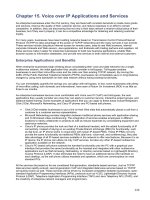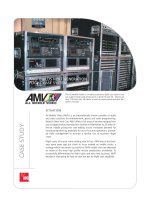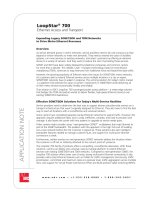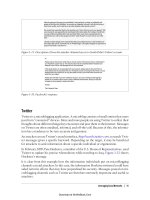Network convergence ethernet applications and next generation packet transport architectures
Bạn đang xem bản rút gọn của tài liệu. Xem và tải ngay bản đầy đủ của tài liệu tại đây (28.6 MB, 586 trang )
NETWORK
CONVERGENCE
NETWORK
CONVERGENCE
Ethernet Applications and
Next Generation Packet
Transport Architectures
VINOD JOSEPH and
SRINIVAS MULUGU
AMSTERDAM • BOSTON • HEIDELBERG • LONDON
NEW YORK • OXFORD • PARIS • SAN DIEGO
SAN FRANCISCO • SINGAPORE • SYDNEY • TOKYO
Morgan Kaufmann is an imprint of Elsevier
Publisher: Steve Elliot
Editorial Project Manager: Kaitlin Herbert
Project Manager: Malathi Samayan
Designer: Mark Rogers
Morgan Kaufmann is an imprint of Elsevier
225 Wyman Street, Waltham, MA 02451, USA
Copyright # 2014 Elsevier Inc. All rights reserved.
No part of this publication may be reproduced or transmitted in any form or by any means,
electronic or mechanical, including photocopying, recording, or any information storage and
retrieval system, without permission in writing from the publisher. Details on how to seek
permission, further information about the Publisher’s permissions policies and our arrangements
with organizations such as the Copyright Clearance Center and the Copyright Licensing Agency, can
be found at our website: www.elsevier.com/permissions.
This book and the individual contributions contained in it are protected under copyright by the
Publisher (other than as may be noted herein).
Notices
Knowledge and best practice in this field are constantly changing. As new research and experience
broaden our understanding, changes in research methods or professional practices, may become
necessary. Practitioners and researchers must always rely on their own experience and knowledge in
evaluating and using any information or methods described herein. In using such information or
methods they should be mindful of their own safety and the safety of others, including parties for
whom they have a professional responsibility.
To the fullest extent of the law, neither the Publisher nor the authors, contributors, or editors, assume
any liability for any injury and/or damage to persons or property as a matter of products liability,
negligence or otherwise, or from any use or operation of any methods, products, instructions, or
ideas contained in the material herein.
Library of Congress Cataloging-in-Publication Data
Joseph, Vinod.
Network convergence : Ethernet applications and next generation packet transport architectures /
Vinod Joseph, Srinivas Mulugu.
pages cm
Includes bibliographical references and index.
ISBN 978-0-12-397877-6 (pbk.)
1. Ethernet (Local area network system) 2. Packet transport networks. 3. Computer network
architectures. 4. Convergence (Telecommunication) 5. Internetworking (Telecommunication) I.
Mulugu, Srinivas. II. Title.
TK5105.383.J68 2013
004.6–dc23
2013025197
British Library Cataloguing-in-Publication Data
A catalogue record for this book is available from the British Library
ISBN: 978-0-12-397877-6
For information on all MK publications visit our website at
Printed and bound in USA
14 15 16
13 12 11 10 9 8 7 6 5 4 3 2 1
INTRODUCTION
Over the years, Ethernet has become the de facto vehicle for deploying Internet communication transport infrastructures at the access,
aggregation, and even the core aspects. Because of the simplicity,
capacity for scalability, availability, and levels of integration that
Ethernet offers across the various networking layers, it has been
adopted widely across the industry. The objective of the book is
to highlight the convergence of new developments, applications,
and services that are emerging in Ethernet transport.
The book discusses various applications and services that can
be deployed using Ethernet as a converged infrastructure linking
multiple carrier and/or enterprise infrastructures. In the book we
examine several services, such as MPLS Layer 3 VPNs, Point-toPoint and Multi-Point Ethernet over MPLS PWs, and provider
backbone bridging, which is an option available for scaling
Ethernet layer 2 services. We then move on to look at how MPLS
can be used in all Ethernet access, aggregation, and core aspects
to offer services such as mobility and still retain operational scale
and control. We also examine MPLS-TP, a trend that is applicable
in certain Ethernet access environments, before moving on to
discuss how packet and optical layers can be integrated.
Please note that among all the graphics and figures appearing
in this book, all symbols of routers and switches are purely generic
to illustrate a device or concept. None of them represents any
actual vendor. Some of the configuration templates provided
are from actual vendors, such as Juniper, Cisco, and AlcatelLucent. This is to provide diversity and also help the reader relate
to specific topics. It is by no means an endorsement of any vendors or their respective technologies.
Finally, this book is written by the two authors in their own
capacities. It has no affiliation to any organizations they are
directly or indirectly involved with.
ix
1
DEPLOYING ETHERNET
MULTI-POINT SERVICES
USING VPLS
Introduction
In this chapter we take a look at virtual private LAN services
(VPLS) and the various building blocks of deploying multipoint
Ethernet services using VPLS.
Virtual Private LAN Service (VPLS)
Although our topic is VPLS, let us begin by taking a quick look
at MPLS Layer 2 VPNs, also referred to as point-to-point services.
A point-to-point L2 VPN circuit, as defined by the pseudowire
encapsulation edge to edge working group (PWE3) of the Internet
Engineering Task Force (IETF), is a provider service that offers a
point-to-point service infrastructure over an IP/MPLS packet
switched network. The PWE3 working group describes mechanisms for delivering L2 VPN services across this kind of network.
The basic reference model is shown in Figure 1.1.
A pseudowire (PW) is a connection between two provider edge
(PE) devices, which connects two attachment circuits (ACs). An
AC can be a Frame Relay DLCI, an ATM VPI/VCI, an Ethernet port,
a VLAN, a HDLC, a PPP connection on a physical interface, a PPP
session from an L2TP tunnel, an MPLS LSP, etc. During the setup
of a PW, the two PE routers are configured or automatically
exchange information about the service to be emulated so that
later they know how to process packets coming from the other
end. The PE routers use Targeted LDP (T-LDP) sessions for setting
the PW. After a PW is set up between two PE routers, frames
received by one PE from an AC are encapsulated and sent over
the PW to the remote PE, where native frames are re-constructed
and forwarded to the other CE.
1
2
Chapter 1 DEPLOYING ETHERNET MULTI-POINT SERVICES USING VPLS
Figure 1.1
From a data-plane perspective, different PWs in the same
packet-switched network (PSN) tunnel are identified using a multiplexing field. This multiplexing field is an MPLS label, and the
encapsulation of the customer frames over these (MPLS) connections or PWs is defined by the PWE3 working group. PSN tunnels
are implemented in the provider’s network as MPLS LSPs (RSVP,
LDP), or using IP-in-IP (GRE). Figure 1.2 shows the protocol stack
in the core of the provider’s network for Ethernet frames.
Ethernet is particularly appealing to enterprise networkers: It is
mature, reliable, cheap, scalable, and well understood. Common
networking practice is to connect local sites (subnets, floors, or
buildings of a campus) with an Ethernet backbone switch, managing and scoping the network with layer 2 VLANs. So it comes
as no surprise that such network operators would like to be able
to connect sites across a wider area using the same Ethernet backbones. Nor is this interest new; as much as 15 years ago many local
providers were offering metropolitan-area Ethernet services such
as Transparent LAN Service (TLS), based on proprietary technologies, and LAN Emulation (LANE), based on ATM backbones. But
such service offerings were not ideal for the provider due to factors
such as dependency on a single vendor, for a proprietary TLS solution, and prohibitive complexity, for a LANE solution. As Ethernet
technology itself advanced, permitting greater speeds at greater
transmission distances, more recent metropolitan Ethernet offerings have been built around Ethernet switches. But these switchbased infrastructures have their own limitations, primarily lack of
scalability due to the numeric limitations on VLAN IDs.
In recent years, VPLS has arisen as a practical, economical, and
scalable alternative for creating metro Ethernet services. VPLS, in
Chapter 1 DEPLOYING ETHERNET MULTI-POINT SERVICES USING VPLS
Figure 1.2
turn, has been made possible by the advent of MPLS, which has
seen accelerating deployment in carrier and service provider networks beginning in the late 1990s. MPLS provides a means of creating virtual circuits, similar to Frame Relay DLCIs and ATM VCI/
VPIs, over IP networks. Its appeal is its ability to eliminate Frame
Relay and ATM infrastructures while moving the services provided
by those infrastructures to an IP network, thereby reducing the
overall capital and operational costs of the network. These MPLS
virtual circuits—called label-switched paths (LSPs)—have for many
years been used to provide Layer 3 IPv4 VPNs and Layer 2 point-topoint VPNs. More recently, the technology has been extended to
support Layer 3 IPv6 VPNs, Layer 3 Multicast VPNs, and VPLS.
The advantage of VPLS for the service provider is in building on
the capital and operational cost savings of an MPLS VPN network: a
3
4
Chapter 1 DEPLOYING ETHERNET MULTI-POINT SERVICES USING VPLS
common IP/MPLS infrastructure with no Ethernet switches
required to support the VPLS, and a common set of standardsbased protocols to support all services, simplifying the management of the network. Supplying the desired service to the customer
is a simple matter of installing and configuring the correct interface.
While the advantages of VPLS described here benefit the service provider, from the customer’s perspective there is nothing
to differentiate VPLS from any other metro Ethernet solution,
beyond possibly having some of the provider’s cost savings passed
along as a less expensive service. However, service providers who
add an inter-provider element to their VPLS offering, can differentiate themselves from competitors by providing their customers
with an expanded “service footprint.”
Figure 1.3 shows the VPLS reference model.
In Figure 1.3 an IP/MPLS backbone network (the packetswitched network, PSN) operated by a service provider offers a VPLS
service to two VPN customers: an Orange customer and a Red
Figure 1.3
Chapter 1 DEPLOYING ETHERNET MULTI-POINT SERVICES USING VPLS
customer. Each customer has private sites that it wants to interconnect at the Ethernet layer. Customer sites are connected to the SP’s
backbone via attachment circuits (AC) between customer edge (CE)
devices and provider edge (PE) devices. As such, a VPN can be represented by a collection of CE devices. In this illustration, the Orange
L2VPN N consists of < CE11, CE12, CE21, CE31, CE41 > while the
Red L2VPN M consists of < CE22, CE31, CE32, CE42, CE43 > .
As with all PE-based VPNs, with VPLS, the CE devices are unaffected by the service: a VPLS CE can be a standard router, or an
Ethernet bridge or host. It is the PE device that implements
VPLS-specific functions. Indeed, the PE device needs to implement a separate virtual forwarding instance (VFI)–also known
as virtual switched instance (VSI), the equivalent of VRF tables
for MPLS Layer 3 VPNs)–for every VPLS it is attached to. This
VFI has physical direct interfaces to attached CE devices that
belong to the VPLS, and virtual interfaces or pseudowires that
are point-to-point connections to remote VFIs belonging to the
same VPLS and located in other PE devices. These PWs are carried
from one PE to another PE via PSN tunnels. From a data-plane
perspective, different PWs in the same PSN tunnel are identified
using a multiplexing field. This multiplexing field is an MPLS
label. The encapsulation of the customer Ethernet frames over
these MPLS connections or PWs is defined by the PWE3 working
group. PSN tunnels are implemented in the provider’s network as
MPLS LSPs (RSVP, LDP) or using IP-in-IP (GRE). Figure 1.4 shows
the protocol stack in the core of the provider’s network.
A Draft-Rosen MVPN represents itself as an emulated LAN.
Each MVPN has a logical PIM interface and will form an adjacency
to every other PIM interface across PE routers within the same
MVPN. This is illustrated in Figure 1.__.
Note that with VPLS, a full mesh of PSN tunnels between the
network’s PE devices is assumed, and for every VPLS instance there
is a full mesh of pseudowires between the VFIs belonging to that
VPLS. The IETF Layer 2 VPN working group has produced two separate VPLS standards,0 documented in RFC 4761 and RFC 4762
(see Kompella and Rekhter, Jan. 2007, and Lasserre and Kompella,
Jan. 2007). These two RFCs define almost identical approaches with
respect to the VPLS data plane, but they specify significantly different approaches to implementing the VPLS control planes.
VPLS Control Plane
The VPLS control plane has two primary functions: autodiscovery and signaling. Discovery refers to the process of finding all PE
routers that participate in a given VPLS instance. A PE router can be
5
6
Chapter 1 DEPLOYING ETHERNET MULTI-POINT SERVICES USING VPLS
Figure 1.4
configured with the identities of all the other PE routers in a given
VPLS instance, or the PE router can use a protocol to discover the
other PE routers. The latter method is called autodiscovery. After
discovery occurs, each pair of PE routers in a VPLS network must
be able to establish pseudowires to each other, and in the event
of membership change, the PE router must be able to tear down
the established pseudowires. This process is known as signaling.
Signaling is also used to transmit certain characteristics of the
pseudowire that a PE router sets up for a given VPLS.
BGP-VPLS Control Plane
The BGP-VPLS control plane, as defined by RFC 4761, is similar
to that for Layer 2 and Layer 3 (see Kompella, Jan. 2006, and Rosen
and Rekhter, Feb. 2006). It defines a means for a PE router to
Chapter 1 DEPLOYING ETHERNET MULTI-POINT SERVICES USING VPLS
Figure 1.5
discover which remote PE routers are members of a given VPLS
(autodiscovery), and for a PE router to know which pseudowire
label a given remote PE router will use when sending the data
to the local PE router (signaling). With the BGP-VPLS control
plane, BGP carries enough information to provide the autodiscovery and signaling functions simultaneously. See Figure 1.5.
The details for de-multiplexer fields will be discussed in the following sections. As in the BGP scheme for Layer 2 and Layer 3
VPNs, a route target is configured on each PE router for each VPLS
present on the PE router. The route target is the same for a particular VPLS across all PE routers and is used to identify the VPLS
instance to which an incoming BGP message pertains. For each
VPLS on each PE router, an identifier, known as a site identifier,
is configured. Each PE router involved in a particular VPLS must
be configured with a unique site identifier. The site identifier is the
same as the virtual edge identifier (VE ID) referred to in RFC 4761,
which prescribes one VE ID per PE for each VPLS instance, irrespective of how many local ports belong to that VPLS. A label
block is a set of de-multiplexer labels used to reach a given VPLS
site within a set of remote sites. The PE router uses a label block to
send a single common update message to establish a pseudowire
with multiple PE routers, instead of having to send an individual
7
8
Chapter 1 DEPLOYING ETHERNET MULTI-POINT SERVICES USING VPLS
Figure 1.6
message to each PE router. A number of illustrations in the following sections elaborate on this in greater detail.
Note: Each PE router creates a virtual connection table (VCT)
per VPLS instance. The VCT is similar to the virtual forwarding
instance (VFI) referred to earlier in this chapter). Hence the terms
VCT and VFI are used interchangeably in this chapter.
Figure 1.6 shows a JUNOS Configuration snippet describing
the basic setup of a BGP-based VPLS instance. The configuration
here is exactly the same as the configuration for BGP/MPLS Layer
3 VPNs, with the exception of the keyword “VPLS” defined under
the protocols hierarchy, which in the case of BGP/MPLS VPNs
would BGP or OSPF or RIP, etc.
Figure 1.7 illustrates a two-site VPLS instance created between
two PE routers clarifies the configuration statements provided
above, and their relevance.
In Figure 1.7, PE2 allocates a label base of “2000” for a given
VPLS instance: VPLS RED. PE3 uses label base “3000” for the same
VPLS instance. The illustration that follows shows the role of the
label base.
In Figure 1.8, PE2 has been allotted 3002 by PE3, as the inner
label to be used to reach Site 3 on PE3. Similarly PE3 will use
2003 as the Inner label for reaching Site 2 on PE2. Another label
would be used by each of the PE routers, if they needed to connect
to another site within the same VPLS instance (VPLS RED) on
another PE. The MPLS outer labels are also displayed in PE2’s
VFT (Label 640).
If more PE routers are added to VPLS instance RED, each of
them uses different label. This is illustrated in Figure 1.9.
Chapter 1 DEPLOYING ETHERNET MULTI-POINT SERVICES USING VPLS
Figure 1.7
In PE2’s VFT, site-id “1” and site-id “15” have different MPLS
outer and inner labels. This indicates that those sites belong to different PE routers. The same is the case with PE3.
LDP-VPLS Control Plane
In contrast to the BGP-VPLS control plane, the LDP-VPLS control
plane provides only signaling but no autodiscovery (more on this in
the following sections). In this control plane, LDP is used to signal
the pseudowires that interconnect the VPLS instances of a given
customer on the PE routers. The LDP signaling scheme for VPLS
is similar to the LDP scheme for point-to-point Layer 2 connections
(see Martini et al., Apr. 2006). In the absence of an autodiscovery
mechanism, the identities of all the remote PE routers that are part
of a VPLS instance must be configured on each PE router manually.
The virtual circuit identifier (VCID), which is in the point-topoint Layer 2 connection used to identify a specific pseudowire,
is configured to be the same for a particular VPLS instance on
all PE routers. Hence, the VCID enables a PE router to identify
9
10
Chapter 1 DEPLOYING ETHERNET MULTI-POINT SERVICES USING VPLS
Figure 1.8
the VPLS instance to which the LDP message refers. This is illustrated in Figure 1.10.
LDP-VPLS and BGP-VPLS Forwarding Planes
Forwarding plane procedures, at least for unicast and to some
extent for multicast (which we will see later in this chapter), are
the same for BGP-VPLS and LGP-VPLS. For each VPLS, a PE VPLS
data plane functions as a learning bridge and supports all the
standard bridge operations, such as MAC address learning, aging,
and flooding. All the pseudowires established by BGP or LDP signaling and the local customer edge (CE) router ports of a VPLS
instance constitute the logical ports of a bridge domain.
Chapter 1 DEPLOYING ETHERNET MULTI-POINT SERVICES USING VPLS
Figure 1.9
Figure 1.10
11
12
Chapter 1 DEPLOYING ETHERNET MULTI-POINT SERVICES USING VPLS
A MAC forwarding table is created for each VPLS instance on a
PE router. This table is populated using a source MAC address
learning function and is used to forward unicast VPLS traffic
based on the destination MAC address of the received frame.
The control plane of VPLS does not need to advertise and distribute reachability information; it uses address learning of the standard bridge function in the data plane to provide reachability. Just
like an Ethernet switch, the VPLS floods all the received Ethernet
packets with unknown unicast addresses, broadcast addresses,
and multicast addresses to all ports (i.e., all the ports and PWs
associated with the VPLS instance.).
To forward a packet, a PE must be able to establish an MAC forwarding database (FDB). Different from the BGP/MPLS Layer 3
VPN that uses the route advertisement mechanism to establish a
routing table in the control plane, the VPLS uses the standard bridge
learning function to establish the FDB in the forwarding plane. The
MAC address FDB is established by MAC address learning, which
includes learning packets from UNI/Attachment Circuit and
packets from PWs. The MAC address learning process has two parts:
• Remote MAC address learning associated with PWs connected
to remote PE routers
• Local MAC address learning of the port directly connected to
the user attachment circuit
The MAC learning process is shown in Figure 1.11. The process
starts with a user having MAC address A and IP address “1.1.1.2”
try to reach MAC address B connected to a remote PE. The ingress
PE floods the packet across all PWs for the relevant VPLS instance
(if the destination MAC address is unknown). In this case, one of
the PE router responds to the ARP request originated by the
sender’s MAC address. The ingress PE builds its MAC database
with the relevant MAC-Address-PW/Remote PE for future use.
The illustration also shows that another PE router, in the same
VPLS instance, also builds its MAC FDB with an entry for MAC A.
Autodiscovery for LDP-VPLS
The previous section discussed how LDP-based VPLS traditionally relied on manual and static configurations on all participating PE routers. For instance, if a new customer with 20 sites
were to be provisioned in the network, each PE router would need
to be configured with all the customer-specific details, such as the
VC-ID, to facilitate creating a PW with each PE router. If a new customer site were later added to these initial 20 sites, all the PE
routers would again need to be configured to identify this new
site. The configuring has to be performed manually, which
Chapter 1 DEPLOYING ETHERNET MULTI-POINT SERVICES USING VPLS
Figure 1.11
becomes an operational nightmare in a large carrier network,
because of the large the number of touch-points involved in provisioning new sites or customers.
LDP-VPLS can now rely on BGP for autodiscovery (AD). BGP AD
is a framework for automatically discovering, connecting, and maintaining the endpoints for a VPLS instance. It provides one-touch provisioning for LDP-VPLS where all the related PEs are discovered
automatically. The service provider can use existing BGP policies
to regulate the exchanges between PEs. The procedure does not
require carriers to uproot their existing VPLS deployments and
change the signaling protocol just to provide discovery functions.
The BGP protocol establishes neighbor relationships between
configured peers. An OPEN message is sent after the completion
of the three-way TCP handshake. This OPEN message contains
information about the BGP peer sending the message, including
the Autonomous System Number, BGP version, timer information, and operational parameters, including capabilities. The
capabilities of a peer are exchanged using two numerical values,
the address family identifier (AFI) and subsequent address family
13
14
Chapter 1 DEPLOYING ETHERNET MULTI-POINT SERVICES USING VPLS
identifier (SAFI). These numbers are allocated by the Internet
Assigned Numbers Authority (IANA). A peer that announces a
capability AFI 65 (L2VPN) and SAFI 25 (BGP-VPLS) is indicating
support for BGP AD. The complete list of AFI and SAFI allocations
can be found at these URLS: “ />address-family-numbers” and “ />safi-namespace.”
Following the establishment of the peer relationship, the discovery process begins as soon as a new VPLS service is provisioned on the PE. Two VPLS identifiers are used to indicate the
VPLS membership and the individual VPLS instance:
1. VPLS-ID – membership information and a unique networkwide identifier. The same value is assigned for all VPLS
switch/forwarding instances belonging to the same VPLS. It
is encodable and carried as a BGP extended community in
one of the following formats:
• A two-octet AS-specific extended community
• An IPv4 address-specific extended community
2. VSI-ID – a unique identifier for each VSI/VFI, built by linking a
route distinguisher (RD) with a 4 bytes identifier (usually the
system IP of the VPLS PE). It is encoded and carried as a
BGP-VPLS NLRI: i.e., RD:IP.
To advertise this information BGP AD employs a simplified version of the BGP-VPLS NLRI, where just the RD and the next 4 bytes
(VE ID and VE Block Offset) are used to identify the VPLS instance.
There is no need for label block and label size fields, as T-LDP will
take care of signaling the service labels later on. The resulting format of the BGP AD NLRI is very similar to the one used for BGP/
MPLS Layer 3 VPNs, as depicted in Figure 1.12. The system IP may
be used for the last 4 bytes of the VSI ID, further simplifying the
addressing and the provisioning process.
Network layer reachability information (NLRI) is exchanged
between BGP peers, indicating how to reach prefixes. With VPLS,
the NLRI is used to tell PE peers how to reach the VSI, rather than
specific prefixes. The advertisement includes the BGP next hop
and a route target (RT). The BGP next hop indicates the VSI location and in the next step is used to determine which signaling session should be employed for PW signaling. The RT, also coded as
Figure 1.12
Chapter 1 DEPLOYING ETHERNET MULTI-POINT SERVICES USING VPLS
an extended community, can be used to build a VPLS full mesh or
an H-VPLS hierarchy, using BGP import/export policies. BGP is
only used to discover VPN endpoints and exchange reachability
information. It is not used to signal the PW labels. This task
remains the responsibility of targeted-LDP (T-LDP).
Exploring the topic of T-LDP further: Two LDP FEC elements
are defined in RFC 4447 (PW Setup and Maintenance Using
LDP). The original PWid FEC element 128 (0x80) employs a 32bit field to identify the virtual circuit ID and was used extensively
in early VPLS deployments. The simple format is easy to understand, but it does not provide the required structure for the
BGP autodiscovery function. To support BGP AD and other new
applications, a new Layer 2 FEC Element, the generalized PWid
FEC element 129 (0x81) is required.1
The generalized PWid FEC element has been designed for
autodiscovery applications. It provides a field, the Address Group
Identifier (AGI), that can be used to signal membership information, for example, VPLS id in the VPLS case. Separate address fields
are provided for the source and target endpoints, called, respectively, Source Attachment Individual Identifier (SAII) and Target
Attachment Individual Identifier (TAII). These are the VSI id for
the two instances to be connected through the signaled PW.
The format for FEC 129 is depicted in Figure 1.13.
Each FEC field is designed as a sub-TLV equipped with its own
type and length, providing support for new applications. To
accommodate the BGP AD information model, the following
FEC formats are used:
• AGI (type 1), which is identical in format and content with the
BGP extended community attribute used to carry the VPLSID value
• Source AII (type 1), a 4-bytes value destined to carry the local
VSI-id (outgoing NLRI minus the RD)
• Target AII (type 1), a 4-bytes value destined to carry the remote
VSI-id (incoming NLRI minus the RD)
BGP is responsible for discovering the location of VSIs that
share the same VPLS membership. LDP protocol is responsible
for setting up the PW infrastructure between the related VSIs by
exchanging service-specific labels between them. Once the
local VPLS information is provisioned in the PE, the related PEs
participating in the same VPLS are identified through BGP AD
exchanges. A list of far-end PEs is generated and will trigger
LDP-specific functions: such as the creation, if required, of
1
More detailed information for each FEC can be found in sections 5.2 (0x80) and 5.3
(0x81) of RFC 4447.
15
16
Chapter 1 DEPLOYING ETHERNET MULTI-POINT SERVICES USING VPLS
Figure 1.13
T-LDP sessions needed by these PEs and the exchange of servicespecific VPN labels. The steps for the BGP AD process and the LDP
session establishment and label exchange are shown in Figure 1.14.
Implementations allow for PWs that are provisioned and autodiscovered manually to coexist in the same VPLS instance, that is,
both FEC 128 and FEC 129 are supported. This allows autodiscovery to be introduced gradually into an existing VPLS deployment.
Still, since FEC 128 and 129 represent different addressing
schemes, it is important to make sure that just one of them is used
at any point in time between the same two VPLS instances. Otherwise both PWs may become active, causing a loop that might
cause the service to malfunction. Hence it is recommended to disable the FEC 128 PW in a portion of the network as soon as the FEC
129 addressing scheme is introduced there. Alternatively, a Layer 2
protocol such as RSTP may be used during the migration provide
additional protection against operational errors.
Chapter 1 DEPLOYING ETHERNET MULTI-POINT SERVICES USING VPLS
Figure 1.14
Autodiscovery for LDP-VPLS – Implementation Details
This section looks at details of implementation to understand
the concepts just discussed. For this purpose we are using a
TiMOS (Alcatel-Lucent) specific configuration only. We are not
illustrating other vendor implementations (JUNOS or Cisco
IOS/XR), since the objective of this section is simply to examine
the level of configuration detail required for BGP AD.
Based on Figure 1.15, let’s assume PE6 was previously configured with VPLS 100, as indicated by the configuration lines in the
upper right. The BGP AD process will commence after PE134 is
configured with the VPLS 100 instance shown in the upper left,
a simple, basic BGP AD configuration. The minimum requirement
for enabling BGP AD on a VPLS instance is configuring the VPLS-id
and pointing to a pw-template.
In many cases VPLS connectivity is based on a PW mesh. To
reduce the configuration requirement, the BGP values can be
automatically generated using the vpls-id and the PE router-id.
By default, the lower six bytes of the vpls-id are used to generate
the RD and the RT values. The VSI-id value is generated from the PE
router-id. All of these parameters are configurable and can be
coded to suit the customer’s requirements and to build different
17
18
Chapter 1 DEPLOYING ETHERNET MULTI-POINT SERVICES USING VPLS
Figure 1.15
topologies. In the configuration above, a VPLS instance named
“Customer 1” with a service-identifier of “100” is created. BGP
AD is configured along with the VPLS-ID for this instance, which
is configured as “65535:100.” This is similar to the RD in the context of a BGP/MPLS VPN. The MTU SIZE is also set to 1478 bytes.
The command “PW-Template” is defined under the top level
service command and specifies whether to use an automatically generated service distribution path (SDP). By definition,
an SDP acts as a logical way of directing traffic from one PE to
another through a uni-directional service tunnel.
A SDP originating on one node terminates at a destination
node, which then directs incoming traffic to the correct egress service access point (SAP), as it is known in TiMOS, or UNI. The easiest way to refer to an SDP is to consider it as the equivalent of a
PW. An SDP can be automatically created using a PW-Template or
by manual configuration, wherein each VPLS customer/instance
is associated with a given SDP. Two types of SDPs can be used in a
VPLS deployment:
• Spoke SDP: Flooded traffic received on the spoke SDP is replicated on all ports within the same VPLS instance, with split
horizon assumed.
• Mesh SDP: Flooded traffic received on any mesh SDP is replicated to all ports within the same VPLS instance, with the
exception of not being forwarded on any mesh SDP.
Chapter 1 DEPLOYING ETHERNET MULTI-POINT SERVICES USING VPLS
Figure 1.16 Commands for PW Binding
SDP deployment is discussed further in subsequent sections.
Now we will look at some commands: The command given in
Figure 1.16 provides the set of parameters required for establishing the PW binding described in the sections that follow.
A pw-template-bind command configured within the VPLS
service under the bgp-ad subcommand is a pointer to the pwtemplate that should be used. If a VPLS service does not specify
an import-rt list, then that binding applies to all route targets
accepted by that VPLS. The pw-template-bind command can
select a different template on a per import-rt basis. Further, it is
possible to specify pw-templates for some route targets with a
VPLS service and use the single pw-template-bind command to
address all unspecified but accepted imported targets. In the configuration shown above, the pw-template-bind 1, binds template
1 with a set of given characteristics to a particular VPLS instance.
The various command options are given in Figure 1.17.
It is important understand the significance of the split horizon
group used by the pw-template. Traditionally, when a VPLS
instance was created manually, the PWs were automatically
19
20
Chapter 1 DEPLOYING ETHERNET MULTI-POINT SERVICES USING VPLS
Figure 1.17 Options for the PW-Template Command
placed in a common split horizon group to prevent forwarding
between the PWs in the VPLS instances. This prevented loops that
would have otherwise occurred in the Layer 2 service. However,
with a VPLS service using BGP autodiscover, the service provider
has the option of associating the autodiscovered PWs with a split
horizon group to control the forwarding between PWs.
Once the VPN endpoints have been discovered using BGP,
T-LDP is triggered. The T-LDP session between the PEs is established when one does not exist. The Far-End IP address required
for the T-LDP identification is gleaned from the BGP AD next
hop information. The pw-template and pw-template-bind configuration statements are used to establish the automatic SDP or to
map to the appropriate SDP (if a PW is already established
between two PE routers and a new site is coming up on one of
these PEs). The FEC 129 content is built using the following values:
• AGI from the locally configured VPLS-id
• The SAII from the locally configured VSI-id
• The TAII from the VSI-id contained in the last 4 bytes of the
received BGP NLRI
The illustration in Figure 1.18 shows in detail the different
phases of the LDP signaling path, after BGP AD is complete. It also
shows how some fields can be autogenerated when they are not
specified in the configuration.
Now to check a few operational commands as given in
Figure 1.19: The first command displays the LDP peering
relationships that have been established. The type of adjacency
is displayed in the Adj Type column. In this case the type
is Both, meaning link and targeted sessions have been successfully
established.
Chapter 1 DEPLOYING ETHERNET MULTI-POINT SERVICES USING VPLS
Figure 1.18
Figure 1.19 Verifying the LDP Session
The second command, in Figure 1.20, shows the specific LDP
service label information broken up according to its FEC element
type, either 128 or 129. The information for FEC element 129
includes the AGI, SAII, and TAII. The SDP-ID is a number assigned
to the PW or SDP between the two PE routers for the given VPLS
instance.
To further understand specific topologies and their implementations in regard to BGP AD, we will consider several use cases in
later sections of this chapter.
21









